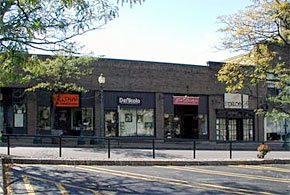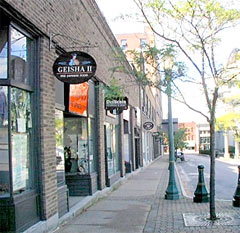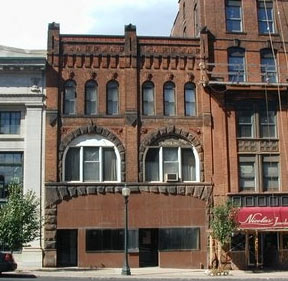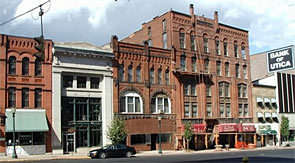
A shot of the building on Bank Place as it is today. This is the
building were Utica's first AM radio station was located. The first station
occupied a corner space in the J and M Music Store on Bank Place, located
between Genesee and Union Streets in downtown Utica.
The first AM radio outlet was located in a music store, the J and M Music Company, 26-30 Bank Place in downtown Utica, New York. That was a few steps from Union Street which accommodated a Utica trolley line. The trolley traveled south on Genesee Street to Blandina Street, negotiated a left turn on Blandina, right turn on Union Street, a right turn at Union Street to Hopper, left on Hopper to Steuben Street and to various streets in the Cornhill section of the city. Utica, at this time, was a veritable street network of trolley tracks providing inexpensive public transportation. On Union Street was located the Union Street School, a city public school which had a high enrollment to help educate the youth whose families resided in the downtown Utica neighborhoods, a bustling, thriving place. In the year 1922, the Cornhill section of Utica had the most population. South Utica, as we know it today, was not part of the city. In 1921 and in 1925,the City of Utica annexed a section of New Hartford from Prospect Street to Brookline Drive. North Utica was mostly farmland, or vacant land. Because of the population totals, and affordable prices, business and the quality of life in Utica was good.

Radio was the result of experiments conducted by Guglielmo Marconi, an Italian inventor, whose original idea was to provide wireless communication between land stations and to the ships at sea. His invention got him awarded a Nobel Prize in Physics in 1909 for promoting wireless telegraphy. In America, radio broadcasting was on the cusp of becoming a tremendous commercial, economic success which, ultimately, provided employment opportunities for countless thousands. Thankfully, Utica was one of the first to adapt to the new technology.

The first radio station in Utica, New York was called WSL, operating on a power of 10 watts using the 1100 frequency.


This photo is of Bank Place in Utica, between Union Street and Genesee
Street. The building on the left is the location of Utica's first AM radio
station. It was situated in the J and M Music Store.
It was part of the J and M Music Store, the station operating in a corner of the music store at 26-30 Bank Place. The store itself had to have a lot of square footage to accommodate the pianos, phonographs and other musical instruments. The President was: M H Johnson, the vice-president was Albert C. Gilbert and Secretary was H G Hatfield. A music store would be an unlikely place to accommodate facilities for a radio broadcasting operation. I checked the 1922 Utica City Directory and found that the J and M Music Store was also a place of business for electrical contractors. On hand were Mike Gruber, Bill "Nessler" Terrill and Howell Parry who were amateur radio operators , known as "ham" radio operators. Mike Gruber is reported to be the manager of the operation.

This was a type of radio broadcasting station facility as is known this day. It was a rudimentary operation. It had installed a sloping board on which to place its technical equipment. Everything was exposed. No cabling was used, all was done with heavy wire, sometime gold plated. WSL utilized a MOPA amplifier (Master Oscillator Power Amplifier)

Again, there were no scheduled programs as with today's highly structured stations of today. Employees of the J and M Music store provided whatever entertainment was used. Viola Parry played the piano in the front window of J and M Music. It has been suggested that the operation of Radio Station WSL, Utica, New York took to the airwaves to advertise their fine pianos. There was a ban on the use of phonograph records on the air. What at tremendous evolution in the record industry, first with the cylindrical disk, then the lateral disks, and then the Remsen Disk.. The Remsen disk was a metal disk which had to be played with a soft "stick" such as a needle made of cactus, no metal was used for it would destroy the disc and render it unplayable. Mr. Terrill asserts that phonograph

The building in the middle, has white paint borders on second floor, is
the location of the first WIBX radio facility. This building, known as the
Clark Building, is located on Genesee Street, directly across from the
former Savings Bank of Utica (now Partner's Trust) Bank.
records of that period had a warning that radio air play was strictly prohibited. Bill says it was self-imposed rule by the record companies. Jack Gray of Utica remembers as a member of a local band who entertained "live" on WSL. Musical entertainment was provided by local musicians; network radio was in the distant future.

The radio station licenses were granted at that time by an agency in the United States Commerce Department, the Federal Trade Commission. The licenses were signed by Herbert Hoover who was the Commerce Secretary. From the year 1922 onward, the radio frequency band was becoming crowded with requests for more and more amplitude modulation stations. Radio stations were proliferating with grand profusion so it was obvious there was need to create a special agency of the federal government to help put some order to this new form of broadcasting. In 1934, there was created by an Act of Congress, the Federal Communications Act which established the Federal Communications Commission as a regulatory agency— assigning licenses, supervising radio station operations, administering examinations for technical personnel. The congressional act also conformed to provisions of treaties made with foreign governments as to the allocation of radio frequencies and the control of broadcasting power. A radio station, after this time, could not exceed 50-thousand watts of operating power. Radio Station WSL ceased its broadcasts in the year 1925 coincidentally when Radio Station WIBX was granted permission to engage in radio broadcasts. Station WIBX also in downtown Utica. Actually, it was not too far from the location of the J and M Music Company on Bank Place. WIBX was located at 236 Genesee Street in a building known as the Clark Building. Henry and Josephine Barnard of Paris Road in New Hartford, NY and Allen and Janet Schrock, 7 Leslie Avenue, Utica, NY obtained a certificate of Incorporation for Grid-Leak, Inc. The language of the certificate, as obtained from the Oneida Clerk's office, recites the purpose of the formation for this corporation was to......

"........to deal in radio and radio appliances....and to maintain and operate radio sending and receiving stations, or both......"

The Clark building on Genesee Street is directly across from the former Savings Bank of Utica and now is the Partner's Trust.

A one-tube transmitter was purchased which transmitter was powered by a six-volt battery. A power generator was used to supply the needed power. And, again, the bare wire was featured extensively in this operation also; there was soldering at all. A flat top antenna was carried to the roof of the building from where the WIBX radio signal was sent into the ether. Wire connections were made by wrapping a wire around a bolt stock to keep the wire in place.

WIBX received its permit to operate on July 29, 1925 and took "to the air" on December 5, 1925.

The following year, the principals of Grid-Leak, Incorporated submitted a new Certificate of Incorporation with the New York Secretary of State, a copy filed in the office of Oneida County Clerk. In the new application, a new item was added to what has been recited above for the start of Grid-Leak, Inc.:
........"to establish and maintain a radio sending station and to broadcast by radio, music, entertainment, speeches, advertising matter and radio messages of all kinds".......


The era of commercial radio had begun in Utica, New York. For the next twenty years, WIBX was the lone radio voice in the Mohawk Valley. WIBX is one of a handful of stations across the country which has retained its original call letters. Today, WIBX is owned by the Regent Broadcasting Group.
'The term, "Broadcasting" was adapted from agriculture in that when there is a casting of the seeds upon the ground, the radio signal did the same in casting his signal in a broad cast of its signal from its source. Hence, broadcasting.

The Amplitude Modulation history of Radio Broadcasting in Utica, New York will continue future editions . Stay tuned. Now the WIBX "studios" were moved from the Clark Building in downtown Utica to studios in the Hotel Utica at 102 Lafayette Street. Stay tuned for the exciting continuation, same time, same website.

I want to end this segment of our research with this amusing story told by Bill Terrill. Each night, Bill would go behind the J and M Music Store on Bank Place. Using a lantern, he would dig for earthworms for the express purpose of feeding his pet snakes. One evening, Bill was spotted by one of Utica's finest who asked Bill what he was doing. When Bill told him the reason for his "digs", the Utica police officer guffawed and said, "Now I've heard everything" and walked away.

One final note. There were no radio announcers then as we understand the term today. That was to come later. But AM radio was on the cusp at this time to become a dominant technology in US history.
A technology which was to change history. Marconi's purpose for the discovery of radio was to find a wireless telegraphy to communicate with all the ships at sea. It was never meant to be a solid financial advertising resource. The greater numbers an AM station could attract, the higher the amounts it could charge for its radio advertising.
In Memoriam
Bill "Nessler" Terrill
1907-2007.